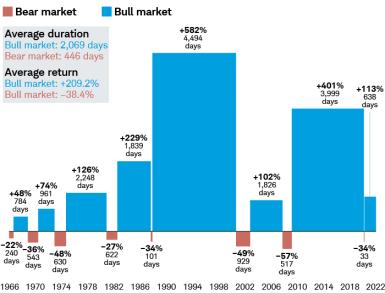7 Things You Can Do During a Volatile Stock Market

Bouts of market volatility are an unnerving, but normal, feature of long-term investing. They’re not fun, but you can expect to see market declines periodically throughout your investing career.
Yet it’s hard to sit still when the market is sliding. You can’t help but think: "Shouldn’t I be doing something?" Every investor is different, but here are a few steps that everyone should consider.
During market volatility:
- Resist the urge to sell based solely on recent market movements. Selling stocks when markets drop can make temporary losses permanent. Staying the course, while difficult emotionally, may be healthier for your portfolio. This doesn’t mean you should hold on blindly, but we suggest taking into account an investment’s future prospects and the role it plays in your portfolio, rather than being guided by noise and fear.
- Take the long view. Markets typically go up and down, and you’re likely to experience several significant declines during a long investing career. But even bear markets—that is, periods when the market fell by more than 20%—historically have been relatively short when compared to bull markets. Because timing the market’s ups and downs is nearly impossible, but all investors would do well to ignore the noise and stay focused on their plans.
Past bear markets have tended to be shorter than bull markets
Source: Schwab Center for Financial Research with data provided by Bloomberg. Data as of 12/31/2021. The market is represented by daily price returns of the S&P 500 index. Bear markets are defined as periods with cumulative declines of at least 20% from the previous peak close. Its duration is measured as the number of days from the previous peak close to the lowest close reached after it has fallen at least 20%, and includes weekends and holidays. Periods between bear markets are designated as bull markets. Indices are unmanaged, do not incur fees or expenses, and cannot be invested in directly. Past performance is no guarantee of future results.
Review your risk tolerance and your risk capacity. Risk tolerance is your ability to emotionally handle big price swings; risk capacity is your financial ability to take a loss. Market downturns can be a wake-up call to reconsider your risk tolerance, although we recommend waiting until you're calm. Risk capacity, however, can—and should—be considered at any time. Do you have enough cash to handle near-term goals? Money that you’ll need soon or that you can’t afford to lose shouldn't be in the stock market—it's best invested in relatively stable assets, such as money market funds, certificates of deposit (CDs), or Treasury bills. If you’re retired, having your next 12 months of living expenses in a bank account or money market fund—and a few more years’ worth in bonds that mature when you need the money—can help you stay calm when stock markets are not.
Make sure you have a diversified portfolio. Volatile markets also can reveal that portfolios their owners thought were appropriately diversified in fact aren’t. If you haven’t looked at your portfolio recently to make sure you understand what each asset class is doing and that the mix matches your target asset allocation, now is a good time to become reacquainted with it. Schwab’s investor profile questionnaire can help you determine your profile and match it to an appropriate target asset allocation.
Consider including defensive assets for more stability. Defensive assets, such as cash and cash equivalents, Treasury securities and other U.S. government bonds, can help stabilize a portfolio when stocks are slipping. Also, if you expect to spend from your portfolio within the next few years, it’s a good idea to keep that money in assets that historically have been relatively liquid and less volatile than stocks, such as cash and short-term bonds. This can help you avoid having to sell in a down market.
Rebalance your portfolio as needed. Market changes can skew your allocation from its original target. Over time, assets that have gained in value will account for more of your portfolio, while those that have declined will account for less. Rebalancing means selling positions that have become overweight in relation to the rest of your portfolio, and moving the proceeds to positions that have become underweight. It’s a good idea to do this at regular intervals.
Adapt your trading to fast-moving markets. If you must trade during volatile markets, take current conditions into account when entering orders. Be careful when trading during the first and last hours of the trading session, which tend to be the most volatile. Trade smaller positions, and consider "scaling" in or out of positions by buying or selling stock in increments as the price fluctuates. There are defensive steps you can take to protect an unrealized gain or limit potential losses on an existing position, such as stop orders and stop-limit orders.1 These can help make your decision-making more automatic and less reliant on doing the right thing in the heat of the moment.
1 There is no guarantee that execution of a stop order will be at or near the stop price.
What you can do next
Read more about Schwab’s perspective on current markets.
Talk to us about the services that are right for you. Call us at 800-355-2162, visit a branch, find a consultant or open an account online.
 By
By
